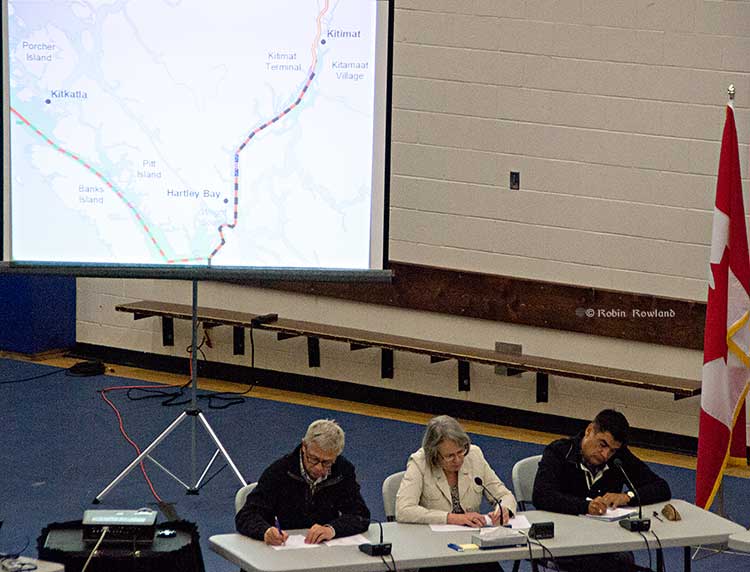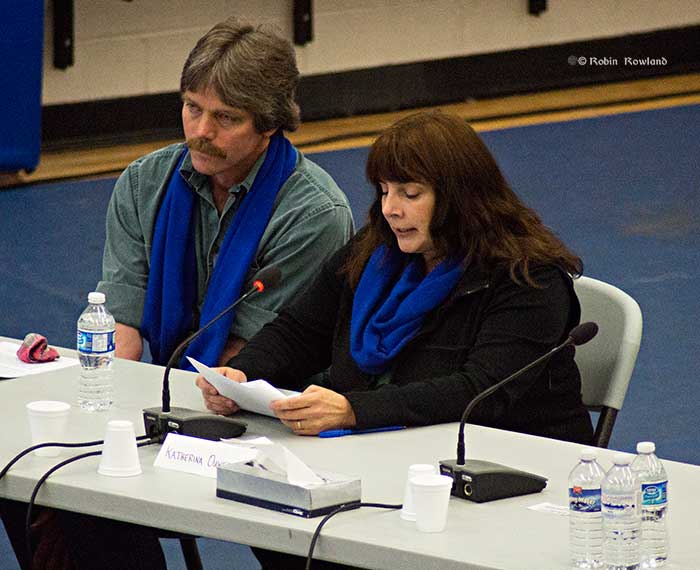
“This will be the first project in Canadian history to have First Nations, environmentalists and, for a lack of a better term, rednecks standing together in protest,” that sentence from Katherina Ouwehand summed up the first day of public comment testimony Monday, June 25, 2012, as the Northern Gateway Joint Review Panel returned to the Haisla Recreation Centre at Kitamaat Village.
Ten minutes isn’t that long. Ten minutes is the time that the Northern Gateway Joint Review Panel gives a member of the public to express their opinion on the controversial Enbridge project that would pipe oil sands bitumen from Alberta through the port of Kitimat to Asia.
Ten minutes is sufficient if you know what you’re talking about, if you’ve done your homework and rehearsed presentation so it can comes in right on time.
Ten minutes can be eternity if you’re an Enbridge official sitting silently at a nearby table as people who do know what they’re saying tear apart your public presentations, your multi-million dollar ads and the thousands of pages the company has filed with the Joint Review Panel. Or perhaps, as some at the public comment hearings pointed out, those ten minutes mean little if Prime Minister Stephen Harper has already decided the pipeline will go ahead no matter what, and thus any recommendation from the JRP has little credibility.
The first witness to appear before the public comment hearings on Monday afternoon was someone who knows all about the role of human error in accidents, Manny Aruda, an Emergency Response Team leader at the Rio Tinto Alcan smelter.
Aruda began by commenting, “To be clear, I do not belong to any environmental or radical organization, although I do recycle and occasionally I do eat granola.” His responsibilities at RTA include overseeing anything related to an emergency response, including dealing with spills and reporting the spills. Before that he worked at Methanex first in operations as a field operator and then as an ammonia control room operator. He also volunteers as a Search Manager for Kitimat Search and Rescue.
Talking about his time in the control room at Methanex, Aruda said, “I worked in the state-of-the-art chemical plant which is constantly being updated with the newest instrumentation. No matter how many safety features are in place, human error could supersede. Incorrect wires were cut causing plants to shut down; drain lines were left open during start-up causing methanol to go into the effluent system and eventually into the ocean; pigs [robots that operate inside pipes] are used to clean pipelines that were supposed to be collected at the end of a line at the wharf, and over-pressurizing of the line and mental error, leaving a valve open and the next thing you know pigs really do fly right into the ocean.
“Enbridge has spoken many times about how they’ll use smart pigs. Perhaps their smart pigs will know when to put the brakes on and stop.
Humans weak link
“The bottom line is that no matter what state-of-the-art infrastructure, instrumentation, safety

measures are in place human decisions or lack of decisions will affect the outcome. Humans are the weak link.
“There is an enormous pressure from management to keep plants and pipelines running. Control room operators are most at risk on start-ups and shutdowns, when conditions are changing rapidly. When a suspected issue arises it requires interpretation and analytical skills. These skills are relative to the amount of knowledge and experience of the individual.
“When in the control room you can’t see, hear or smell what’s going on outside, this is why the field operator is so valuable and utilized to go out in the field to verify a level, check a pump status, a pressure reading, identify leaks, et cetera.
Despite what some people may believe, it’s not black and white. There’s not a red Staples easy button flashing indicating that a spill is happening.
“When in the control room you can’t see, hear or smell what’s going on outside, this is why the field operator is so valuable and utilized to go out in the field to verify a level, check a pump status, a pressure reading, identify leaks… Despite what some people may believe, it’s not black and white. There’s not a red Staples easy button flashing indicating that a spill is happening.”
Any deviation from normal operations is subject to interpretation by the control room operator, “a human, the weak link,” Aruda said. He added: “Industry can continue to make improvements and make things more and more idiot-proof. History has shown that better idiots will come along.”
He told the JRP that the long Northern Gateway pipeline through remote mountain passes would have no field operators available to check every kilometre of the line to verify what the control room operator thinks is happening.
Like other witnesses, Aruda pointed to the Enbridge spill at Marshall, Michigan, where four million litres were spilled into a river in a populated area. “The spill went unnoticed due to human error,
the weak link.”
He testified that he has spent “hundreds of hours looking at Enbridge’s risk assessment,
management of spills, emergency response,” and then he said from the point of view of an
emergency response team leader, “reading these documents has flabbergasted me.” He said Enbridge’s risk management was “seriously deficient and woefully lacking in substance. They do not take into consideration the rugged terrain, the climatic conditions and dangers of fast flowing moving water.”
He said Talmadge Creek that feeds the Kalamazoo River, the location of the spill in Michigan, flows at much slower rate than the Kitimat River. At Kalamazoo, he said, four million litre oil spill moved 39 miles downstream contaminating everything in its path and it was contained two days later.
“It took Enbridge two days to deal with a meandering Kalamazoo River spill. Enbridge has stated in their risk assessment and management of spills they can contain a spill in the Kitimat River within two to four hours. This is irresponsible and inaccurate statement with no associated details.
It rains a lot in Kitimat
“To be fair, the Marshall spill happened at the worst possible time when the Kalamazoo River flows were at flood stage, causing oil to be deposited high on marshes and banks. This caused widespread contamination in the area. The Kitimat area also has high periods of flows and flood stages. It’s called, May, June, September, October and November. I’m not sure if you’re aware, but it rains here, a lot.
“In a worst-case scenario for the Kitimat River, Aruda said, based on events of September 2011, “heavy rain caused a dramatic increase in river levels within 24 hours. This is a normal occurrence. And the river widens by 75 yards in some locations. I have personally witnessed tree after tree, including 100 foot trees with full root balls 20-feet in diameter barrelling down this river. The Kitimat River flow at that time, 72,000 cubic feet a second, [was] some 18 times more than the Kalamazoo River. There’s not one qualified incident commander that would even consider sending out emergency responders into that raging river.”
He said that even during a moderate rise of the river, booms are not effective because of all the debris floating down the river.
Aruda said, “I invite anyone who thinks this oil spill can be cleaned up effectively to drift down the river with me to see for themselves how impossible a task that would be.” He noted that Enbridge has spent $765 million in clean-up costs, and while some parts of the Kalamazoo River have recently been opend for recreational use, other parts remain closed for clean-up.
He repeated his belief that Enbridge’s response plans are insufficient and concluded by saying, “Other pipelines and transmission lines have succumbed to the forces of nature in this area without any long-term environmental impacts. Sadly, this will not be the case if oil spills here.”
A later witness was Terry Brown, a former project engineer at Eurocan. Brown began by describing his love for sailing the Douglas Channel for the past 28 years. In one instance, Brown said, “ One extra-special night was when the ocean waters were disturbed and the phosphorescence was a glow like fireworks. We were seldom alone on the water as we often saw, heard and smelled seals, sea lions, orcas, and humpback whales, just like a huge aquarium but all to our own and so secluded.
“We not only stayed on the surface but some of our family engaged in scuba diving. What a joy to see so much life, crabs, fish, and shrimp, sea anemones, sea lions and much more. What a gorgeous dive it was as our daughter Stacy and I went down deep on the wall at Coste Rocks to see many different life forms hanging in our view. Later, we circumnavigated the rock and were amazed to see the pure white forms of a large sea anemone.”

Things failed
Like Aruda, he then turned to how things can go wrong. “No matter how hard we tried to do our best, things failed or as they often said, ‘shit happens’. Pipes, gaskets would fail; tanks would collapse; equipment would break. We even had SRBs in our stainless tanks. Many items would fail with such power that it would resemble an explosion.
“Lately, I have heard comments on how new gaskets are much better than old. Our experience was the opposite, as old gaskets contained asbestos they had a much better life span than the new synthetic ones.
“My largest project at Eurocan, a 300-tonne per day CMP pulp mill, actually had 10 — that’s it, 10 major failures within the first one to two years after start-up. During my working time, I was also involved in some of the projects to reduce the tainting of the local oohlican fish. This involves a highly cultural activity that the Haisla engaged in up until Eurocan start up in 1970.
“Over the 10 to 15 years spent looking for a solution, some $100 million was spent on related activities. If this much was spent with no success on a minor issue, if you call it that, how can anyone expect to clean up the beaches of a real nasty oil like dilbit?”
There was a third, highly technical presentation from Kelly Marsh, a millwright with the District of Kitimat (as well as Kitimat Search and Rescue volunteer) who presented his mathematical evidence, based on what he said we standard and accepted models that he said showed that Enbridge has vastly underestimated the chances of spill.
For the first time in public, some voiced in public what many in Kitimat have been saying in private, that if Stephen Harper pushes the project, there will be resistance from the residents of Northwestern British Columbia.
Katherina Ouwehand testified, “I am not a bully and I don’t lose my temper easily, but if this project is given the go-ahead by our Prime Minister, they had better be prepared for a huge fight. My thousands of like-minded friends and I will unite in force and do more than
speak up peacefully. There will be many blockades on the pathways of the pipeline and marine blockades in the channel.”
Murray Minchin, a member of Douglas Channel Watch (although everyone at the public comment hearings are testifying on their own behalf) said, “The original organizers of the Clayoquot Sound clear-cut logging blockades hoped that 500 to 600 people would turn out and help them protest. Over 10,000 showed up and almost 1,000 were arrested. Those numbers will be shattered if this project gets steamrolled through the regulatory process.”
Bill C-38
Many of the witnesses voiced their concerns about the Conservative omnibus Bill C-38 which they said would destroy many of the environmental safeguards in the Fisheries and Environmental Assessment Acts.
Margaret Ouwehand said. “I have a great fear. I am afraid of Enbridge because it represents much more than a pipeline; Enbridge is an enabler of all the things that make us ashamed to be Canadian. Do we want a Canada that endangers the whole world by contributing to global warming?
Do we want a Canada that muzzles scientists who don’t say what the oil companies want them to say? Do we feel proud when Canada puts up roadblocks to treaties with other countries so that oil companies can continue to pollute? Do we really want a Canada that prefers temporary foreign workers to be used and, in many cases, abused, just to provide oil companies with cheap labour? Wouldn’t it be more ethical to encourage immigrants to come to Canada to make permanent homes and actually contribute to the country?
“Once we were proud of Canada’s leadership in protecting the environment, both in Canada and world-wide. Now we have sold out to the highest bidders and by so doing we are jeopardizing our very sovereignty. We cannot enter into agreements to limit pollution because the big oil companies who own our resources won’t allow it.
“Once we were the world’s good guys, the peacekeepers, the ones who were caretakers of the environment and of endangered species. Now it’s all about money. Now we are at the bottom of the heap, along with other money-grubbers of the world.”
Mike Langegger, who has testified at previous National Energy Board and JRP hearings on behalf of the Kitimat Rod and Gun, testified, “Today I wish to speak to the implications of the Northern Gateway Project will have on my and many coastal families who call British Columbia home and the threat it poses to a generations of culture, lifestyle, relying on healthy and productive environment and ecosystems we currently have.
“My family, along with many resident British Columbians have a strong connection to our natural environment and is as much part of us as we are of it. By nature we are hunters and gatherers who have sustainable harvest from our natural environment over the generations providing for our families. Abundant and healthy fish and wildlife populations in environment that sustained their existence is critical and must be guaranteed.
“Unfortunately, over my lifetime I’ve witnessed commercial and industrial exploitation come and go, each diminishing our areas natural environment and its ability to support wildlife and the many associated values. It is critical that not only negative implications of the Northern Gateway Project be considered but also the cumulative effects of current, proposed, and past exploitation that has or is likely to occur in our area. Often a single negative impact can be mitigated. However, when a series of impacts are allowed to compile, the end result has proven to be devastating.
“Today the Dungeness crab and our local estuary area are deemed as contaminated and not recommended for consumption. The oohlican populations have been wiped out on most of our local area streams. The Kitimat River has been negatively impacted by resource extractions rendering it reliant on hatchery augmentation. Trees on the west side of the valley have died off suspect to pollution; wildlife populations have been impacted and the list goes on.
“We have seen industries come and exploit our area and its resources, profit substantially and leave, only to pass on a legacy of toxic sites and compromised environment. What they have not left behind is any established fund for impacted First Nation’s area residents and stakeholders to manage and reinvest back into our environment for the benefit of habitat, fish, wildlife that has been impacted.
“Ultimately, industry in general has been allowed to exploit, profit, and leave without being held accountable for our forest to correct damage. That’s the history we currently witness here.
“For those of us that call coastal British Columbia home, the existing environment, fish, wildlife, and associated values are the foundation of who we are. It is those values that foster and nurture many family bonds and are the result of cherished memories with loved ones and friends. It is those values that provide a healthy lifestyle and food source. It is those values that support numerous traditions and are the base of revered culture. It is those values that the Northern Gateway Project ultimately threatens to extinguish.”
Transcript Vol.58-Mon June 25, 2012 (pdf)


